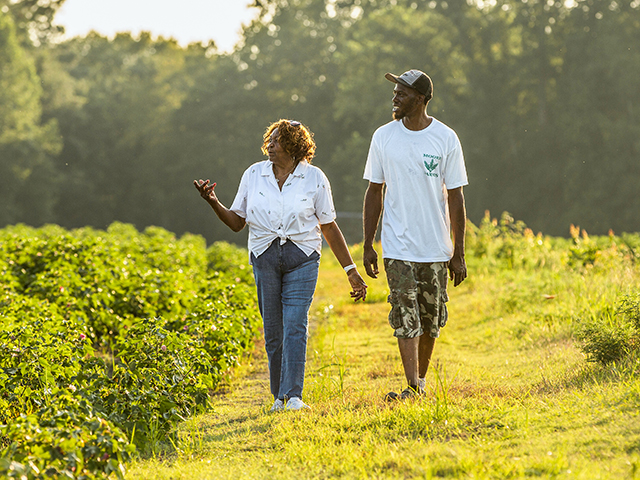Landowner Repopulates Harvested Woodland To Leave a Legacy
Living Legacy
Jessie Moore is carrying on a legacy with a new crop of loblolly pine trees on her North Carolina farm, near Harrelsville. She says it's in honor of her late husband and an investment in her grandchildren. "My husband, William M. Moore, and I started our farming together when we purchased 30 acres from his grandmother in 1972," she recalls. "He was a shipfitter/welder at the nearby Newport News Shipyard, and we worked together building the farm." They grew peanuts, corn, soybeans and cotton over the years and added acreage as they could while William worked off the farm.
"The flatland farm fields have very good, well-drained soil, so if you plant in it and nourish it, you'll get a good harvest," Jessie says. "I've now rented the land to a man I know will continue taking care of it the way William and I did."
Before his death in March 2018, William had arranged for a clear-cutting of mixed hardwood and pine timber on roughly 52 acres of their property. Once the timber was gone, he began planning to reforest it.
"William and I both believed in preserving the land even when we were farming, and replanting trees on the harvested acreage is just part of that process," she says. "You take away something, you put something back. Life is like that."
PLANTING PLANS
To repopulate the harvested woodland, Jessie worked through the Sustainable Forestry and African American Land Retention Project, a partnership between the U.S. Endowment for Forestry and Communities, the USDA's Natural Resources Conservation Service, the U.S. Forest Service and the American Forest Foundation.
P[L1] D[0x0] M[300x250] OOP[F] ADUNIT[] T[]
The project collaborates with Roanoke Electric Cooperative across northeastern North Carolina and is involved with more than 225 landowners, accounting for about 11,000 acres of forest land, says Alton Perry, director of the Roanoke Electric forestry project.
"We try to increase forest-owner income and land asset values through proper management and environmentally sound practices, and open the program to any landowner," he says. It is open to anyone with at least one 8-acre parcel of woodland. Landowners receive technical assistance in replanting their properties after harvest and guidance on how to manage and market their fledgling timber crop. The program has an educational component to help youth and young adults learn to advance sustainable forestry on their family lands.
Perry says since its inception in 2013, the program has helped formulate 120 forest management plans on 6,300 acres and has enrolled 16 landowners in the North Carolina Tree Farm Program. Also, about 6,400 acres of project land have been enrolled in a Present-Use Valuation Program, which provides a reduction in property taxes for participants.
TREE CROP PLANTED
When it was time to replant the harvested acres on the Moore Farm, Michael Hughes, of Greenleaf Timber and Management Inc., from nearby Ahoskie, was the lead consultant. He also had been involved in William's original plans to harvest the acreage. "They replanted in February 2021," Jessie recalls. "I was out there watching, and it only took a day and half."
The project involved planting bare-root improved loblolly pine seedlings on an 8- x 10-foot spacing. The plant material came from International Forest Co., a Moultrie, Georgia, seedling producer.
Loblolly pines are a prevalent species across the South and are used widely in industrial commercial plantings because of their ability to establish and grow quickly, and gain dominance over understory competition naturally. Also, because of its tall, straight growth habits, the loblolly is a favored species for use in high-end wood products such as structural lumber and plywood.
"Overall, we planted about 545 trees per acre and will return in the fall with a brush control spray for emerging broadleaf and woody species, which compete heavily with young trees," Hughes explains. The "release spray" is part of a federal cost-share program designed to help landowners get a better start for their new tree crop by reducing competition for sunlight, water and nutrients.
30-YEAR HARVEST
The Moore Farm planting is on relatively flat terrain on ground adjacent to active farmland. "It's good soil for growing pines, and because of that, it had been in pines years before the recent harvest," Hughes says. "Some people forgo the long wait and clear-cut in about 18 years for pulp wood, but I recommend tree growers thin their stands at 15 years to cull less-dominant, forked or diseased trees, and leave the bigger, more robust trees for saw timber," he explains. A reforestation project such as the Moore's will be ready for final harvest in about 30 years.
Those management and financial decisions will be up to Jessie and her family as the pines grow tall. Now, however, she says she wants to watch the stand develop and enjoy it with her seven grandchildren and seven great-grandchildren, all of whom live within a 45-minute drive of her home.
"This project is something I will be able to enjoy for my husband and to continue something he started for them," she says. "He wanted them to prosper from this long after I'm gone."
[PF_1221]
(c) Copyright 2021 DTN, LLC. All rights reserved.




